To communicate with the Yang (spirits) and announce events to the community, people used the sound of bronze gongs (gong ching).
The people believe that all things have souls, so there are many Yangs that control human life. Therefore, prayers take place continuously according to the lunar calendar, the life cycle, and social relationships. To diversify information, people gradually made rules for each other: to pray to this Yang, they use this sound, to invite that Yang, they play a different sound and rhythm... Dozens of gong songs were created. People from near and far, listening to the sound of gongs, knew what happy or sad events would happen.
The gong songs are divided into groups: groups to invite the gods (Rieo Yang, drong Yang), groups to announce to the community (ieo wit hgum), and groups to welcome guests (Drong tue). We also listen to the rustling story-telling sound of the forest, the roaring sound of the waterfall, the whistling sound of the singing wind, the panting sound of the sun, the murmuring sound of the river and stream from improvised gong songs such as waterfall (Drai ênai), hail (yan pliêr), spinning pinwheels (Kong Dar, Chiriria...)...
Then from just a gong ensemble, bamboo instruments from the forest arose, using the sound of the gong as the standard (hluê ching), adding a means of entertainment after the ceremony and after the days of productive labor. There were also rhymed poetic stories (Klei Khan) about the Ede origin, about the heroic Dam boys, the beautiful H'Bia girls, sung and told all day and night. Hundreds of people listened with fascination...
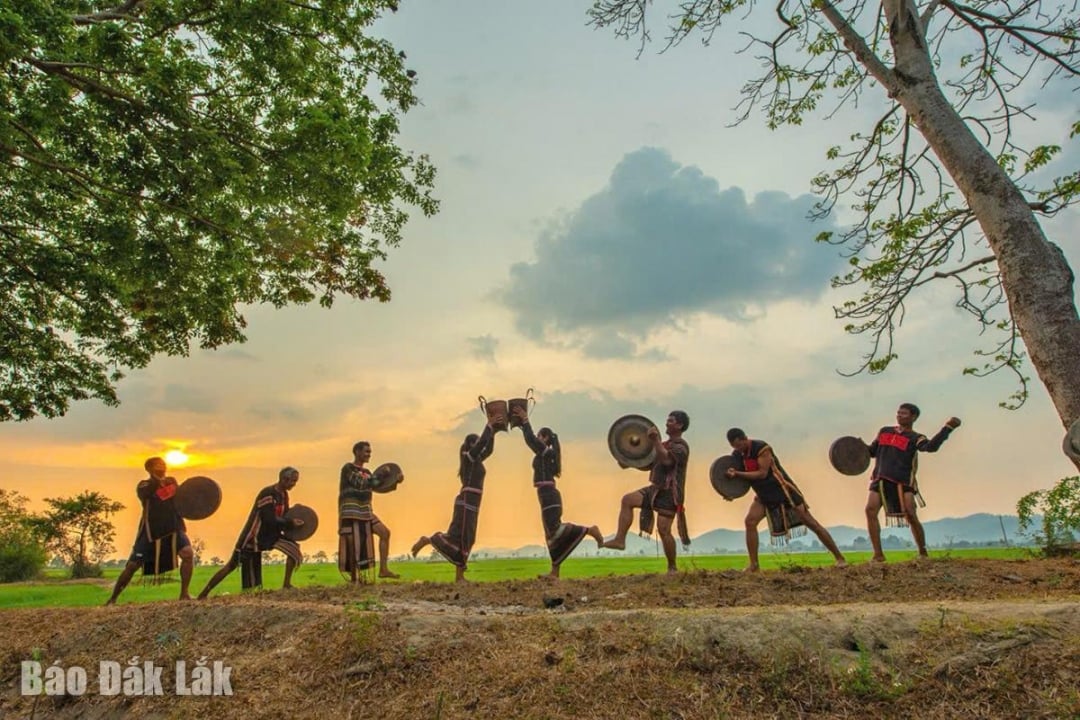 |
| The sound of the jungle. Photo: Huu Hung |
The Ede are among the few ethnic groups with the most traditional musical instruments. In addition to the gongs with the function of inviting the gods and announcing to the community, there are also musical instruments used for narration and confiding (ding buot, tak tar, ding tut, goc); there are musical instruments used only to express love (gong, kni, bro), there are musical instruments used only in funerals (ding nam, ding tut); musical instruments are attack commands (ky pah)...
Because of the continuous ceremonies, along with the need to gather for entertainment after the ceremony and after productive work, in the past, the youth of the ethnic minorities in the Central Highlands had a very high artistic talent. They were born with music in the ear-blowing ceremony to announce to the community the presence of a living being; with the sound of gongs filling their souls and ears according to the family's agricultural calendar (clearing the fields, offering rice to the ears, eating new rice...); following each growing foot after the coming-of-age ceremony (wedding, building a house, giving thanks, wishing grandparents and parents good health...). Those sounds not only resonate but also proudly appear among the mountains, forests, rivers and streams.
Come to my hometown and listen to the sounds of gongs, soft and lyrical like the sounds of the J'rai and Bahnar gongs; cheerful and dancing like the sounds of the Se Dang gongs; strong and heroic like the sounds of the Ede gongs. A whole "group of sounds" made from copper, bamboo, wood and stone, resonates, captivating and inviting. |
I, an Ede woman, have been fascinated since I was not even up to my father's waist. I have been absorbed in the rhythm of the bustling J'rai gong, the solemn sound of the Bahnar gong, the lively and clear Xe Dang gong, the fast and powerful Ede gong. And I will always remember the great awakening in my soul when I heard the sound of the ding tut made of straw that the peasant women brought to greet me in a smoky, dimly lit stilt house in M'Drắk in 1980.
From then on, I just listened. Listening to the invitations of the festivals of drinking Bahnar water (et tnok dak), eating new Ede rice (hoă esei mrâo), celebrating the rice harvest of Jo Long (Ét dong), leaving J'rai graves (Pơ Thi), thanking the Xe Dang (bêne), wishing the M'nong good health, with the vibrant sounds of gong ensembles, immersing myself not only in the sound of music but also in the joy of the community.
It is a pity that, due to many reasons, the unique and beautiful sounds of music and nature of the Central Highlands are no longer as dense in the community as in the past. The young generation, engrossed in so many streams of information and lifestyles from the modern world , no longer loves or understands the customs and practices of the nation, almost abandoning them to pursue "new things", causing not only the sounds of folk songs and traditional musical instruments to disappear for a long time, some musical instruments even disappear completely. Gongs have been improved to play the 7-tone music of the West!
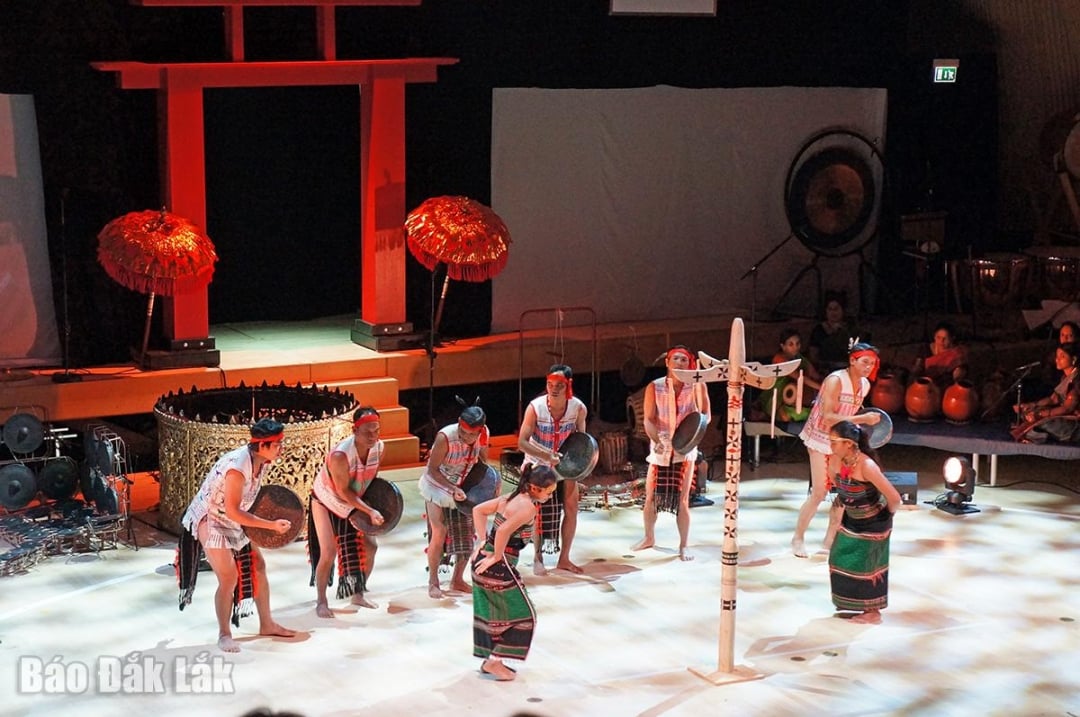 |
| Gongs and M'nong dance on stage in Copenhagen (Denmark). |
Fortunately, after UNESCO recognized the Central Highlands gongs as a representative intangible cultural heritage of humanity, there have been many positive changes. Understanding of traditional cultures of ethnic groups has been raised and spread through communication, propaganda, and advocacy programs... Traditional music has gradually been revived. Currently, in addition to the gong cultural festival, there are also regular performances of traditional musical instruments for tourists to enjoy, such as gong performance programs in the central wards of the Central Highlands...
Community tourism takes indigenous culture, especially the sound of musical instruments as a highlight to attract domestic and foreign tourists. The most popular and widespread are classes teaching gong performance to the young generation. Many artisans in villages voluntarily open classes teaching not only gong performance but also many other traditional musical instruments. Young people present with traditional music sounds in public more and more each day, with a clear sense of pride and honor.
The Central Highlands music is reviving more outside the community. The joy is that the younger generation knows how to listen and appreciate the beauty of their ethnic sounds. They know how to be proud of their traditional costumes not only in performing folk art but also in weddings and daily activities.
And I, who was concerned about the loss and survival of the Central Highlands culture, felt my soul calm, my heart beat peacefully when the breath of the Central Highlands gong culture space throbbed with the rhythm of life on the red plateau.
Come on, hand in hand, let's step into the forest following the sounds of the forest...
Musician
Source: https://baodaklak.vn/tin-noi-bat/202511/lang-nghe-am-thanh-cua-dai-ngan-f6d2b25/



![[Photo] Cutting hills to make way for people to travel on route 14E that suffered landslides](https://vphoto.vietnam.vn/thumb/1200x675/vietnam/resource/IMAGE/2025/11/08/1762599969318_ndo_br_thiet-ke-chua-co-ten-2025-11-08t154639923-png.webp)




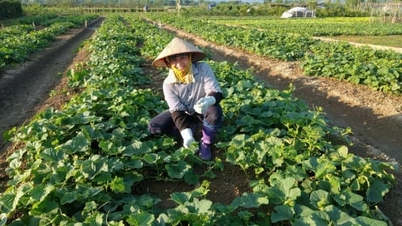








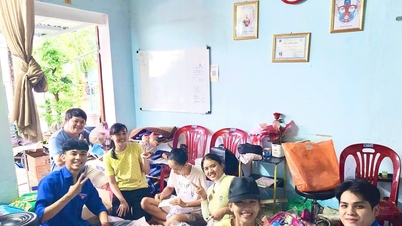













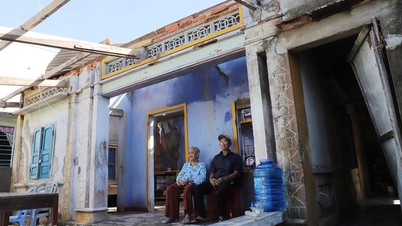
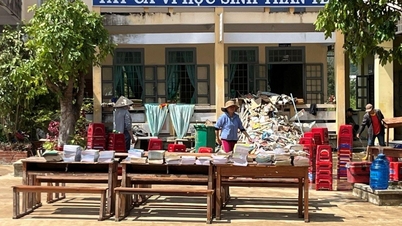















![[Video] Hue Monuments reopen to welcome visitors](https://vphoto.vietnam.vn/thumb/402x226/vietnam/resource/IMAGE/2025/11/05/1762301089171_dung01-05-43-09still013-jpg.webp)





































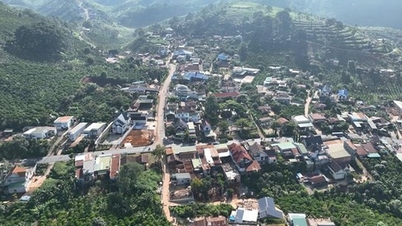











![Dong Nai OCOP transition: [Part 2] Opening new distribution channel](https://vphoto.vietnam.vn/thumb/402x226/vietnam/resource/IMAGE/2025/11/09/1762655780766_4613-anh-1_20240803100041-nongnghiep-154608.jpeg)












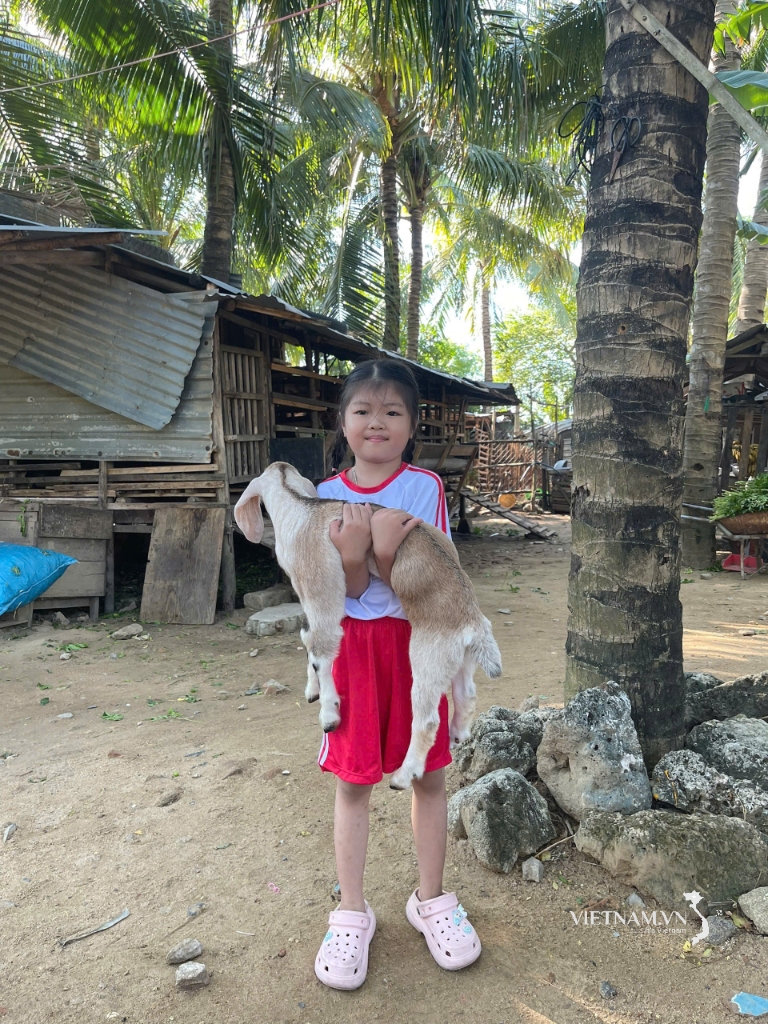
Comment (0)